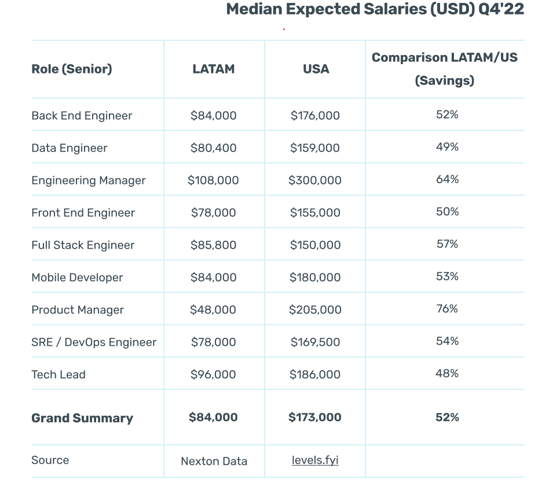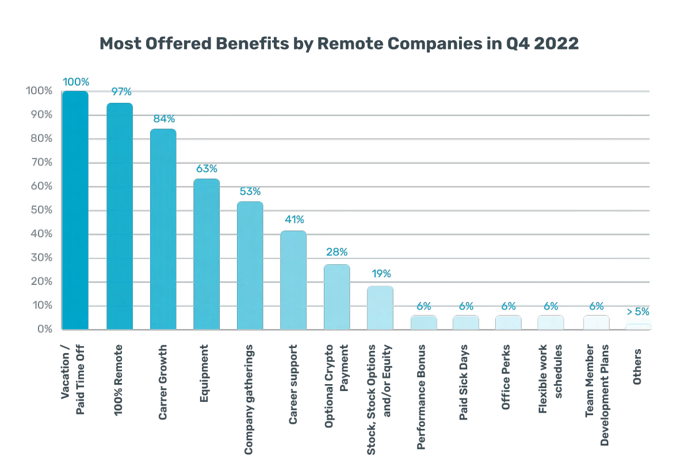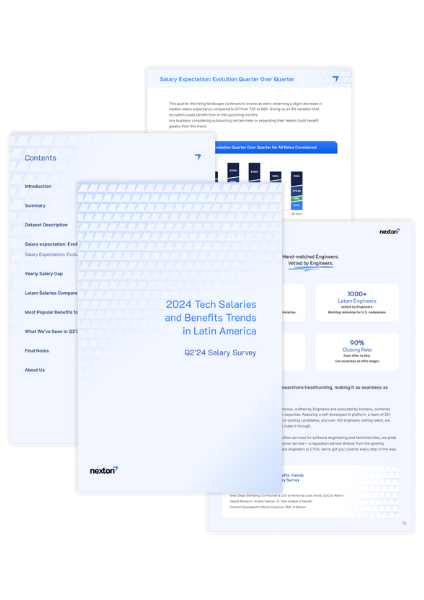Looking to learn about software engineer salaries in Latin America? You're in luck, as we've compiled a guide to help you understand the compensation for software engineers’ jobs in different countries in the region.
There are many factors that influence a software developer's salary in LATAM. Specific location, experience, and tech skills are all important factors to keep in mind. We'll take a look at the average software engineer remote salary in Latin American countries, as well as provide a few statistics from our latest Tech Salaries & Benefits Trends Report on the most valuable and paid tech skills. This guide will help you understand the different salary ranges that tech companies can expect to offer in LATAM.
What Influences the Average Salary?
When a company decides what salary to set up for a remote software developer position, it is essential to understand that the average engineer’s income depends on several factors –skillset, experience, candidate’s location, and what hiring model the company is willing to use when looking for new team members. In this section, let’s explore how different factors influence the median wage.
Skills
Companies that look for remote software developers expect candidates to have strong tech skills, especially regarding the most in-demand programming languages –Python, JavaScript, Java, PHP, among others. Candidates with an advanced understanding of the needed technology stacks are more likely to accept offers from companies that offer better conditions. Our experts recommend checking the market and comparing salaries and benefits for the most in-demand skills you need in order to set adequate compensation. To get a good sense of salary expectations by specific tech role, see our latest report!

Experience
Another thing to keep in mind is that the average software engineer remote salary highly depends on how many years the candidate has dedicated to software development and how well they know the technology they work with.
There are several positions a remote software developer can perform, depending on their experience level: junior, semi-senior, and senior.
- Junior engineers (entry-level) have only recently started their career path and have up to two years of experience. They often have little knowledge of technologies the development team uses, which requires senior developers to help them adapt to the processes and solve issues they may have. Junior programmers do simple tasks that don’t directly influence the software as they still need to learn a lot. But companies can hire entry-level developers for big projects, where seniors can delegate simple tasks to juniors and focus on creating complex solutions.
- Semi-senior remote software developers usually have three to five years of experience and can already develop software independently. These engineers can provide effective software solutions and implement them as they already have enough knowledge and experience. As there is a high demand for senior software developers, you can hire a semi-senior developer who is eager to learn.
- Senior remote software developers usually have from five to ten years of experience. These engineers have a solid knowledge of programming languages, frameworks, development methodologies, and can successfully take over the team lead role. They can participate in core development and provide high-quality software solutions. They often manage junior engineers in the team and check the development process to keep it smooth. If you need an experienced developer at the core development stage or plan to create new software, you need at least one senior engineer on your team to create software solutions.
Working Model
Apart from the needed skills and candidate’s experience, it is also essential to decide on what hiring model you consider the best for your project or business.
There are three types of hiring models that companies use when looking for software developers: in-house, software outsourcing, and hiring freelance on a per-project basis.
- In-house is the option when a company hires engineers as a regular development team for their business. Those remote software developers are very dedicated and motivated to provide high-quality software as they are a part of the company. It is also a useful option if the development process is at the stage of core development and the employer needs highly skilled engineers to begin the project from scratch. In addition, as they are a part of the company, they are more involved in the business part as well, such as providing software solutions that can help the company avoid security problems and being a strong competitor in the market.
- Outsourcing allows assigning the project development to a third party. Here it is possible to get a whole development team with engineers, QAs, designers, and even the PM to manage the work. It is also necessary to mention a suboption of outsourcing –staffing. This hiring model allows scaling the in-house development team with remote software developers from staff augmentation companies of the same expertise level. It is the perfect solution if you lack a specialist with knowledge of a specific technology. With staffing, it is possible to find and hire candidates very quickly.
- Finally, if your company doesn’t have a budget or if the project is short-term and uncomplicated, they can consider freelance developers. You can find needed engineers on freelance platforms where you can see their rates per hour, look through reviews of their previous clients, and see what skills they have. This is the most cost-effective solution as their rates are often lower compared to in-house or outsourced engineers. When hiring a freelance developer, you can also expect them to begin working the same day they were hired. As freelance developers are usually hired for small secondary tasks or projects, companies also avoid the long onboarding stages, as the engineer is focused only on specific tasks. Regarding the disadvantages, you won’t have full control over the development process, the quality of code may be poor, and you should consider the security of your data when you share it with a third party. But this option is still the most cost-effective solution for simple and short projects –or even backlog tasks.
Location
It is well-known that living costs influence the average salary. For example, in Latin American countries, the expected software engineer remote salary varies from USD $72,000 to USD $114,000. While in the U.S., the average expected salary hovers at USD $173,000. Another factor to keep in mind is that LATAM salaries vary depending on the country in which you're hiring. For instance, developers in Brazil and the same developers in Colombia will have different earnings in the same roles.
Taking into consideration everything that was explored in this guide, you should consider not only the specific tech stack and skills you’re looking for, but also other factors that depend on the average developer's salary: experience, location, and hiring model. It will help you find and hire the best match for your needs.

The Median Annual Salary in LATAM Countries
There are several reasons why Latin America is an attractive destination for companies from the U.S. Some of the most advantageous benefits are overlapping time zones, cultural similarities, and an advanced English level, which means communication between teams is smooth and collaboration seamless. Often, U.S. companies also choose to hire developers from Latin America due to the average software engineer remote salary in the region. So, let’s dive deeper into the details of this outsource destination.
Developer’s Position
Let’s look closer at what senior, specialized engineers can expect from the company depending on their tech role in Latin America.

What Are the Most Popular Benefits Among LATAM Engineers?
After having discussed the most in-demand skills in the region, it is good to point out what tech companies are ready to provide for the potential candidates to attract and hire top-tier remote software developers.
From the statistics below, we can clearly see how the pandemic has influenced the tech market. About 97% of companies now provide 100% remote work.
Another benefit that 100% of companies provide is paid time off and vacations. Moreover, 84% of businesses point out that candidates will have the possibility of career growth on their teams.
53% offer company-wide retreats to keep each team member feeling valuable, discuss issues they have, and provide ideas on how to solve them. Career support is another popular bonus that about 41% of companies give to their remote team members.

Source: 2023 Tech Salaries and Benefits Trends: Q4 Report
Summary
While finding the right remote software developer for your specific IT needs can be challenging, there are some key things to keep in mind that will ease the search. For example, it's essential to consider your company's specific project needs, the skills needed, and the pay you are willing to offer.
Remember that software engineers’ remote salary varies depending on their location, experience, and more., so it's essential to do your research.
At Nexton, remote recruiting is our bread and butter. Learn more about how we can help you boost your teams with top-level tech talent. And don’t forget to check out our new Tech Salaries & Benefits Trends Report!


